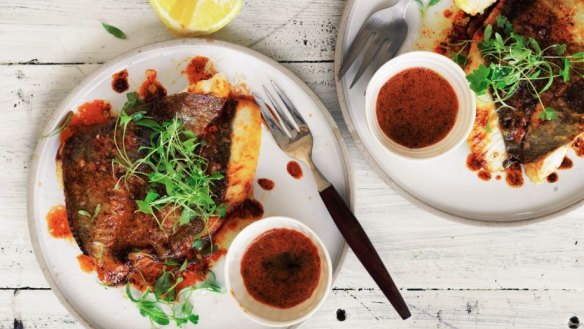What's the best way to use smoked paprika?

Can you suggest some dishes using smoked paprika, other than paella? T. Churchill.
I remember working with Movida's Frank Camorra researching paprika in Extremadura in Spain. We watched as great festoons of ripe red peppers were hung from the rafters in Franco-era concrete tobacco sheds. There they were enveloped in a column of aromatic smoke from a slow-burning oak log. These would stay there for about a week before being ground in little stone mills. The smell was intoxicating: woodsmoke, sweet capsicum, a note that smelled bitter, if possible. This was later packed into pretty little tins and sold as La Dahlia brand. Later we went to the bar where we enjoyed the local snack, soft, gelatinous pigs' tails in vinegar, dusted with smoked paprika. I use smoked Spanish paprika whenever I want that earthy, slightly piquant taste and smoky note. Some went into a steak and onion pie last week. My 13-year-old daughter adds it to her mac and cheese (delicious). I sprinkle some over a winter veg salad before dressing. It loves root vegetables – I add a little to the salt and oil I toss potatoes through before baking. The same with chicken pieces destined for the barbecue – it enhances the smoky note, and there is a hit of umami action from the peppers themselves. The last time I used it was at the weekend when I made popcorn for the kids – butter, salt, smoky paprika – delicioso!
My grandfather used to repeat ad nauseam, "Mustard with mutton is the sign of a glutton!" Can you think of any valid reason for this saying? J. Pritchett
For some reason, when I read this, I had an image of the Major from Fawlty Towers blustering about, hurling random insults at fellow diners. We don't see a lot of mutton these days. It is delicious, especially when cooked properly. Occasionally my good mate James Campbell from the Bunyip Hotel in Cavendish in western Victoria puts great grilled mutton chops, complete with rib bone, on the menu. God, they're good. Cold mutton was a popular breakfast dish in Georgian England. Back then, mustard was wholegrain mustard and expensive to produce. Lower ranks would have soused their mutton with vinegar or even vinegar infused with mint, while those who could afford it used mustard. It would appear that expression derives from some basic class jealousies. The rhyme makes it memorable. (Way too memorable for your poor grandfather, repeating it ad nauseam.) Powdered mustard wasn't developed until about 100 years later when Jeremiah Colman worked out a technique to crush the mustard seeds without damaging the volatile oils that create the burning sensation. The company that he founded and which bears his name still makes mustard.
Letters
Recently we discussed butter knives here at Brain Food, which caused one reader, who wishes to be known as Lady Bracknell, to write in. "I think neither you nor your correspondent's mother-in-law is right about the correct use of the butter knife. Perhaps this is because of confusion commonly made these days between the butter knife (a small knife with a broad, spatulate blade) and a bread and butter knife (a smaller version of a regular table knife). For the record, I was taught to use the butter knife to cut a portion of butter and place it on the side of my plate, then use my bread and butter knife to spread it on my bread/toast/crumpet." Thank you.
Send your vexing culinary conundrums to brainfood@richardcornish.com.au or tweet to @realbrainfood.
Appears in these collections
- More:
- Food
- Brain food
